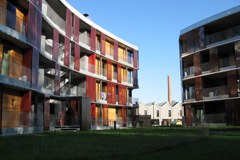News
Negative CO2 balance in the Alpine region
Sep 28, 2007
/
alpMedia
The Alps have the potential to become a model region for climate protection. And yet today, on a global comparison, every inhabitant of the Alps is contributing disproportionately to the greenhouse gas emissions affecting the climate.

Image caption:
There is huge potential for energy savings in the building sector. © CIPRA International
And despite a relatively low settlement density, the significant and largely CO2-neutral generation of electricity using hydraulic power, and the high proportion of forests, the Alpine region has a negative CO2 balance, i.e. it emits more CO2 than it absorbs.
It was against this backdrop that from 20 to 22 September some 140 experts attending the Yearly Symposium of the International Commission for the Protection of the Alps (CIPRA) discussed the potential uses of renewable energies and the possibilities for increasing energy efficiency in the Alpine region. The conference held in St Vincent in the Aosta Valley/I was entitled "The Alps beyond Kyoto".
There was agreement that Alpine countries could and should cover a large part of their energy requirements from renewable forms of energy and improve on the Kyoto targets for reducing greenhouse gas emissions. In the first instance they should seek to conserve energy wherever possible and, secondly, make full use of the vast potential available from improved energy efficiency and the use of renewable resources such as wood, water, sun, wind and geothermal energy. For instance the Alps enjoy almost Mediterranean conditions for the use of solar energy thanks to the intensive solar radiation and the largely mist- and fog-free mountain locations.
Other than potential uses, CIPRA also addressed limitations in the use of renewable forms of energy from an ecological and economic point of view. While the expansion of hydropower is now often criticised for nature conservation reasons, it is important to take account of any negative impact on the natural landscape caused by new wind power installations or large-scale photovoltaic systems.
The Alpine region not only contributes to climate change, it is also disproportionately affected by it. This should provide additional motivation to undertake exemplary efforts aimed at climate protection.
Source: CIPRA International
It was against this backdrop that from 20 to 22 September some 140 experts attending the Yearly Symposium of the International Commission for the Protection of the Alps (CIPRA) discussed the potential uses of renewable energies and the possibilities for increasing energy efficiency in the Alpine region. The conference held in St Vincent in the Aosta Valley/I was entitled "The Alps beyond Kyoto".
There was agreement that Alpine countries could and should cover a large part of their energy requirements from renewable forms of energy and improve on the Kyoto targets for reducing greenhouse gas emissions. In the first instance they should seek to conserve energy wherever possible and, secondly, make full use of the vast potential available from improved energy efficiency and the use of renewable resources such as wood, water, sun, wind and geothermal energy. For instance the Alps enjoy almost Mediterranean conditions for the use of solar energy thanks to the intensive solar radiation and the largely mist- and fog-free mountain locations.
Other than potential uses, CIPRA also addressed limitations in the use of renewable forms of energy from an ecological and economic point of view. While the expansion of hydropower is now often criticised for nature conservation reasons, it is important to take account of any negative impact on the natural landscape caused by new wind power installations or large-scale photovoltaic systems.
The Alpine region not only contributes to climate change, it is also disproportionately affected by it. This should provide additional motivation to undertake exemplary efforts aimed at climate protection.
Source: CIPRA International

